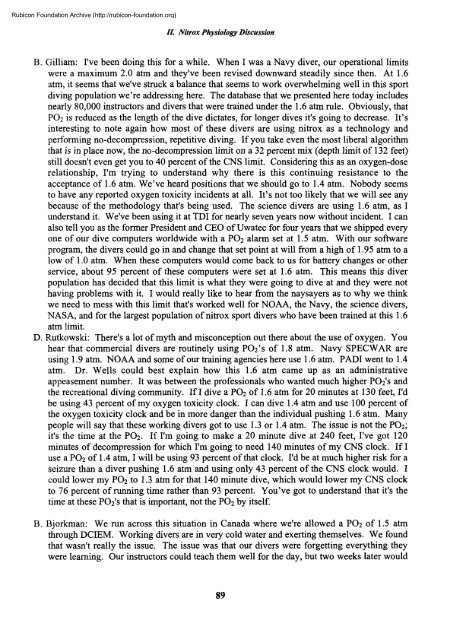Nitrox workshop dings - Divers Alert Network
Nitrox workshop dings - Divers Alert Network
Nitrox workshop dings - Divers Alert Network
You also want an ePaper? Increase the reach of your titles
YUMPU automatically turns print PDFs into web optimized ePapers that Google loves.
Rubicon Foundation Archive (http://rubicon-foundation.org)//. <strong>Nitrox</strong> Physiology DiscussionB. Gilliam: I've been doing this for a while. When I was a Navy diver, our operational limitswere a maximum 2.0 atm and they've been revised downward steadily since then. At 1.6atm, it seems that we've struck a balance that seems to work overwhelming well in this sportdiving population we're addressing here. The database that we presented here today includesnearly 80,000 instructors and divers that were trained under the 1.6 atm rule. Obviously, thatPO2 is reduced as the length of the dive dictates, for longer dives it's going to decrease. It'sinteresting to note again how most of these divers are using nitrox as a technology andperforming no-decompression, repetitive diving. If you take even the most liberal algorithmthat is in place now, the no-decompression limit on a 32 percent mix (depth limit of 132 feet)still doesn't even get you to 40 percent of the CNS limit. Considering this as an oxygen-doserelationship, I'm trying to understand why there is this continuing resistance to theacceptance of 1.6 atm. We've heard positions that we should go to 1.4 atm. Nobody seemsto have any reported oxygen toxicity incidents at all. It's not too likely that we will see anybecause of the methodology that's being used. The science divers are using 1.6 atm, as Iunderstand it. We've been using it at TDI for nearly seven years now without incident. I canalso tell you as the former President and CEO of Uwatec for four years that we shipped everyone of our dive computers worldwide with a PO2 alarm set at 1.5 atm. With our softwareprogram, the divers could go in and change that set point at will from a high of 1.95 atm to alow of 1.0 atm. When these computers would come back to us for battery changes or otherservice, about 95 percent of these computers were set at 1.6 atm. This means this diverpopulation has decided that this limit is what they were going to dive at and they were nothaving problems with it. I would really like to hear from the naysayers as to why we thinkwe need to mess with this limit that's worked well for NOAA, the Navy, the science divers,NASA, and for the largest population of nitrox sport divers who have been trained at this 1.6atm limit.D. Rutkowski: There's a lot of myth and misconception out there about the use of oxygen. Youhear that commercial divers are routinely using PO2's of 1.8 atm. Navy SPEC WAR areusing 1.9 atm. NOAA and some of our training agencies here use 1.6 atm. PADI went to 1.4atm. Dr. Wells could best explain how this 1.6 atm came up as an administrativeappeasement number. It was between the professionals who wanted much higher PO2*s andthe recreational diving community. If I dive a PO2 of 1.6 atm for 20 minutes at 130 feet, I'dbe using 43 percent of my oxygen toxicity clock. I can dive 1.4 atm and use 100 percent ofthe oxygen toxicity clock and be in more danger than the individual pushing 1.6 atm. Manypeople will say that these working divers got to use 1.3 or 1.4 atm. The issue is not the PO2;it's the time at the PO2. If I'm going to make a 20 minute dive at 240 feet, I've got 120minutes of decompression for which I'm going to need 140 minutes of my CNS clock. If Iuse a PO2 of 1.4 atm, I will be using 93 percent of that clock. I'd be at much higher risk for aseizure than a diver pushing 1.6 atm and using only 43 percent of the CNS clock would. Icould lower my PO2 to 1.3 atm for that 140 minute dive, which would lower my CNS clockto 76 percent of running time rather than 93 percent. You've got to understand that it's thetime at these PO2 f s that is important, not the PO2 by itself.B. Bjorkman: We run across this situation in Canada where we're allowed a PO2 of 1.5 atmthrough DCIEM. Working divers are in very cold water and exerting themselves. We foundthat wasn't really the issue. The issue was that our divers were forgetting everything theywere learning. Our instructors could teach them well for the day, but two weeks later would89
















